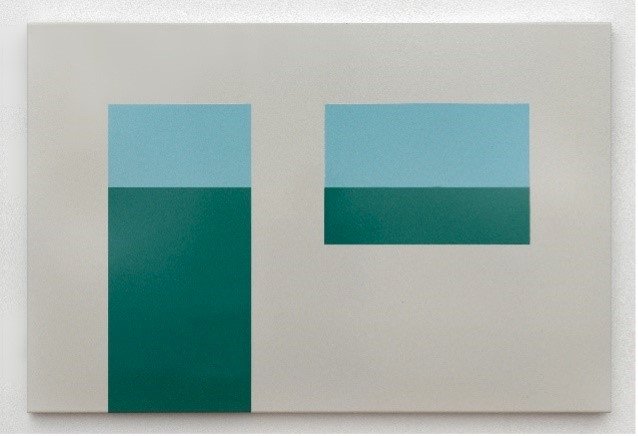

Rafaël Rozendaal (b. 1980)
Mechanical Painting 21 02 11 (Inside Outside)

In addition to a website, specially designed by Rafael Rozendaal for A&O Shearman, and an NFT (non fungible token) work of art, the artist is also represented in the collection with a “physical” work of art: a “painting” executed in enamel. The word painting is in quotation marks. He does not pick up a brush. Rozendaal’s computer is basically his studio in which everything is created. He does make drawings, usually in black ink. Occasionally he exhibits them, but they are especially important as sketches for his artwork on the internet. He shows them to his regular programmer so that they can achieve the desired digital result together.
In addition to this programmer, Rozendaal also works with master printers, weavers and, in the case of his Mechanical Paintings, with enamellers for his designs. As with the minimal artists of the 1960s, the hand of the master is subordinate to the idea, the design and the execution. Rozendaal often works in series. Mechanical Painting 21 02 11 (Inside Outside) also does not stand alone, but is part of a whole series of graphic designs that can be executed in different ways: in enamel, as NFT, as a mural or even in book form. The prestigious Parisian art publisher Threestar Books made the artist’s book Home Alone with Rozendaal in Covid year 2020 with similar screen-printed graphic designs.
Serial work is of all times. An artist often studies a theme, form or subject for several years to see how far you can go before you get the most out of it. Rozendaal’s production in series has partly grown due to his way of working on the computer. Many of his NFTs are based on algorithms that can generate infinite variations within a style or genre. This is not to say that Rozendaal just pushes a button. He is the artist, creator and guardian of his vector graphics. The computer program associates this, within the limits and editions set by the artist. He regularly launches or “drops” a series of NFTs that are closely related but unique in design and execution.
In Mechanical Painting 21 02 11 (Inside Outside) Rozendaal adequately depicts an architectural space with a few horizontal and vertical lines and three subdued colours with, looking through the door and the window, a landscape and a horizon. Can it be even more minimal? Yes, for example the series Horizons, related to the Mechanical Paintings, in which horizontal rectangles are divided in two by two different colours, one above and one below, creating a horizon in the middle. Deceptively simple, but visually very effective. The viewer will fill in a time of day and a place based on the two colours. Just as you get a sense of time or season at Mechanical Painting 21 02 11 (Inside Outside).
Sometimes as an artist, you are identified with a style or subject. Rafael Rozendaal has now achieved that status. Much of his work, digital or physical, has found its way to famous museums and a large number of collectors. The constant stream of beautiful visual finds within a strictly regulated and carefully chosen colour palette proves to be a recipe for inspiration and success.
Rafaël Rozendaal (b. 1980)
www.likethisforever.com

Where lie the origins of the visual arts? Some point to a few Spanish caves near Málaga, where circa 43,000-year-old petroglyphs depicting seals have been found. In any case, the ancient Greek were already fiercely debating the quality and prestige of painters and sculptors. As time went on, artists renewed and refined their techniques, aided by technical progress. Woodcut printing was introduced in the 14th and 15th centuries, quickly followed by engraving and etching. Photography emerged in the 19th century, a technique that artists eagerly started using in their work. Film and video were a logical next step. Since then the computer has radically changed our lives and while we are still exploring its practical potential, some artists have been using the computer to create art for almost fifty years. Not, that is, to refine existing works of art, but to let the computer create art on the basis of entered data. Dutch artist Peter Struycken is one of those early computer pioneers. The frontrunners of this artistic evolution, turning website creation into an art form, form the first generation of such artists. The fact is that information technology has become an integral part of contemporary art.
In 2011, Allen & Overy Amsterdam bought an art website: www.likethisforever.com, created by Dutch-Brazilian artist Rafaël Rozendaal. The website is unique and specially made for Allen & Overy. Allen & Overy may use this work at all times, project it on walls during events, install it as a screensaver, etc. It is the owner, but may not deny others the pleasure of viewing the art. Anyone can type in the URL and the website will appear on their screens like a true 21st century masterpiece. Rozendaal’s designs are colourful and unpretentious. They are often simple but striking graphic discoveries. During the first years, you’d sometimes come across silly adolescent jokes, but the images become more and more universal and striking, and at times moving.
Rozendaal has struck a chord with this contemporary channel for art. His own website, where you will find all of his cyber‑themed work, had 40 million hits in 2012. By now, he is in demand for exhibitions all over the world. In July 2012, www.likethisforever.com was projected on a façade measuring 80m x 100m on Seoul Square in Korea. Well-known brands now reach out to Rozendaal, asking him for ideas to attract young people.
After he sells a website, Rozendaal reserves the right to sell the same website one more time to a museum or art institution. He then simply creates a .org website alongside the already existing .com URL. This way, the buyer retains exclusivity while Rozendaal keeps the possibility open to exhibit his work in museums.
This exclusivity has become a hot topic since the launch of so-called NFTs (Non-Fungible Tokens), which flooded the art market in early 2021 and resulted in a few huge sales records by relatively unknown online artists. Rozendaal responded quickly to the NFT trend and offered a few of his art websites for sale through a well-known NFT auction site. His pioneering role as an internet artist was honoured: collectors paid unprecedented amounts in crypto-currency for his work.